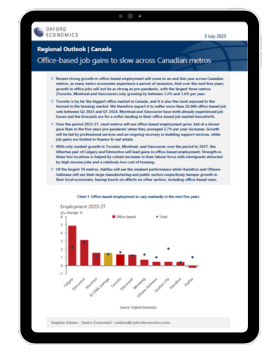Office-based job gains to slow across Canadian metros

Recent strong growth in office-based employment will come to an end this year across Canadian metros, as many metro economies experience a period of recession. And over the next five years, growth in office jobs will not be as strong as pre-pandemic, with the largest three metros (Toronto, Montreal and Vancouver) only growing by between 1.3% and 1.6% per year.
What you will learn:
- Toronto is by far the biggest office market in Canada, and it is also the most exposed to the turmoil in the housing market. We therefore expect it to suffer more than 20,000 office-based job cuts between Q2 2023 and Q1 2024. Montreal and Vancouver have both already experienced job losses and the forecasts are for a softer landing in their office-based job market henceforth.
- Over the period 2023-27, most metros will see office-based employment grow, but at a slower pace than in the five years pre-pandemic when they averaged 2.7% per year increases. Growth will be led by professional services and an ongoing recovery in building support services, while job gains are limited in finance & real estate.
- With only modest growth in Toronto, Montreal, and Vancouver over the period to 2027, the Albertan pair of Calgary and Edmonton will lead gains in office-based employment. Strength in these two locations is helped by robust increases in their labour force with immigrants attracted by high-income jobs and a relatively low cost of housing.
Tags:
Related Services

Service
Canadian Province and Metro Service
Data and forecasts for Canadian provinces and metropolitan areas.
Find Out More
Service
City Climate Analysis
In-depth insights into the economic impacts of climate change and mitigation policies on cities and local economies throughout Europe, the US and Canada.
Find Out More
Service
Global Cities Service
Make decisions about market and investment strategies with historical data and forecasts for 900 of the world’s most important cities.
Find Out More